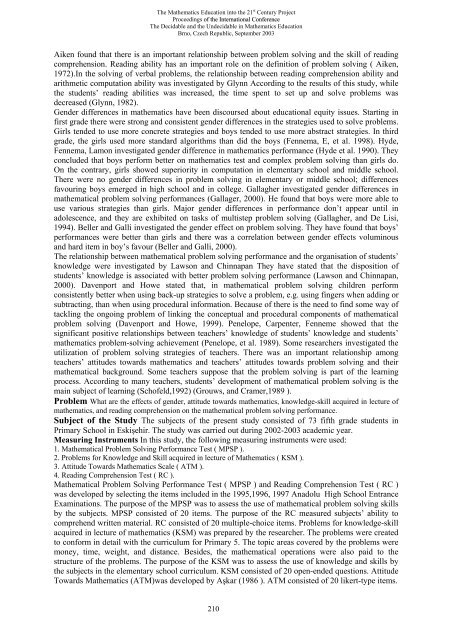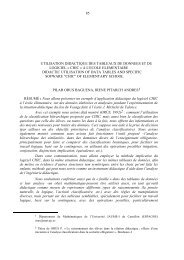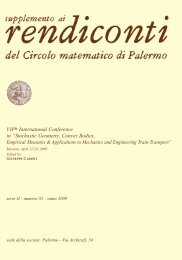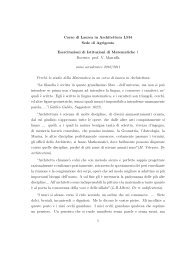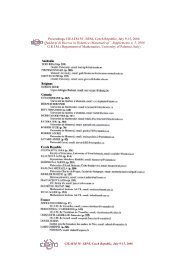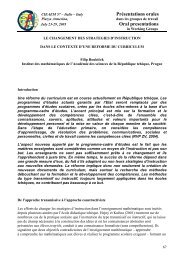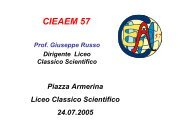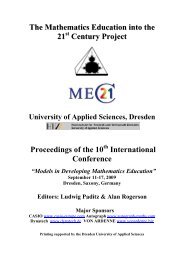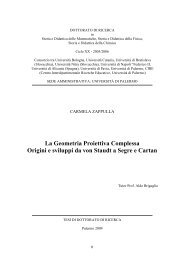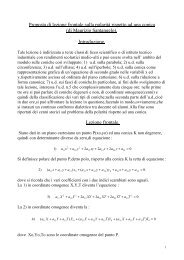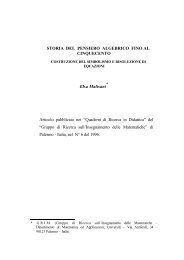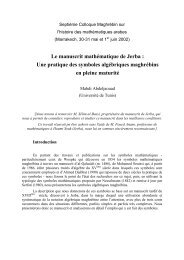Grade Students on the Performance of Mathematical Problem ...
Grade Students on the Performance of Mathematical Problem ...
Grade Students on the Performance of Mathematical Problem ...
Create successful ePaper yourself
Turn your PDF publications into a flip-book with our unique Google optimized e-Paper software.
The Ma<strong>the</strong>matics Educati<strong>on</strong> into <strong>the</strong> 21 st Century Project<br />
Proceedings <strong>of</strong> <strong>the</strong> Internati<strong>on</strong>al C<strong>on</strong>ference<br />
The Decidable and <strong>the</strong> Undecidable in Ma<strong>the</strong>matics Educati<strong>on</strong><br />
Brno, Czech Republic, September 2003<br />
Aiken found that <strong>the</strong>re is an important relati<strong>on</strong>ship between problem solving and <strong>the</strong> skill <strong>of</strong> reading<br />
comprehensi<strong>on</strong>. Reading ability has an important role <strong>on</strong> <strong>the</strong> definiti<strong>on</strong> <strong>of</strong> problem solving ( Aiken,<br />
1972).In <strong>the</strong> solving <strong>of</strong> verbal problems, <strong>the</strong> relati<strong>on</strong>ship between reading comprehensi<strong>on</strong> ability and<br />
arithmetic computati<strong>on</strong> ability was investigated by Glynn According to <strong>the</strong> results <strong>of</strong> this study, while<br />
<strong>the</strong> students’ reading abilities was increased, <strong>the</strong> time spent to set up and solve problems was<br />
decreased (Glynn, 1982).<br />
Gender differences in ma<strong>the</strong>matics have been discoursed about educati<strong>on</strong>al equity issues. Starting in<br />
first grade <strong>the</strong>re were str<strong>on</strong>g and c<strong>on</strong>sistent gender differences in <strong>the</strong> strategies used to solve problems.<br />
Girls tended to use more c<strong>on</strong>crete strategies and boys tended to use more abstract strategies. In third<br />
grade, <strong>the</strong> girls used more standard algorithms than did <strong>the</strong> boys (Fennema, E, et al. 1998). Hyde,<br />
Fennema, Lam<strong>on</strong> investigated gender difference in ma<strong>the</strong>matics performance (Hyde et al. 1990). They<br />
c<strong>on</strong>cluded that boys perform better <strong>on</strong> ma<strong>the</strong>matics test and complex problem solving than girls do.<br />
On <strong>the</strong> c<strong>on</strong>trary, girls showed superiority in computati<strong>on</strong> in elementary school and middle school.<br />
There were no gender differences in problem solving in elementary or middle school; differences<br />
favouring boys emerged in high school and in college. Gallagher investigated gender differences in<br />
ma<strong>the</strong>matical problem solving performances (Gallager, 2000). He found that boys were more able to<br />
use various strategies than girls. Major gender differences in performance d<strong>on</strong>’t appear until in<br />
adolescence, and <strong>the</strong>y are exhibited <strong>on</strong> tasks <strong>of</strong> multistep problem solving (Gallagher, and De Lisi,<br />
1994). Beller and Galli investigated <strong>the</strong> gender effect <strong>on</strong> problem solving. They have found that boys’<br />
performances were better than girls and <strong>the</strong>re was a correlati<strong>on</strong> between gender effects voluminous<br />
and hard item in boy’s favour (Beller and Galli, 2000).<br />
The relati<strong>on</strong>ship between ma<strong>the</strong>matical problem solving performance and <strong>the</strong> organisati<strong>on</strong> <strong>of</strong> students’<br />
knowledge were investigated by Laws<strong>on</strong> and Chinnapan They have stated that <strong>the</strong> dispositi<strong>on</strong> <strong>of</strong><br />
students’ knowledge is associated with better problem solving performance (Laws<strong>on</strong> and Chinnapan,<br />
2000). Davenport and Howe stated that, in ma<strong>the</strong>matical problem solving children perform<br />
c<strong>on</strong>sistently better when using back-up strategies to solve a problem, e.g. using fingers when adding or<br />
subtracting, than when using procedural informati<strong>on</strong>. Because <strong>of</strong> <strong>the</strong>re is <strong>the</strong> need to find some way <strong>of</strong><br />
tackling <strong>the</strong> <strong>on</strong>going problem <strong>of</strong> linking <strong>the</strong> c<strong>on</strong>ceptual and procedural comp<strong>on</strong>ents <strong>of</strong> ma<strong>the</strong>matical<br />
problem solving (Davenport and Howe, 1999). Penelope, Carpenter, Fenneme showed that <strong>the</strong><br />
significant positive relati<strong>on</strong>ships between teachers’ knowledge <strong>of</strong> students’ knowledge and students’<br />
ma<strong>the</strong>matics problem-solving achievement (Penelope, et al. 1989). Some researchers investigated <strong>the</strong><br />
utilizati<strong>on</strong> <strong>of</strong> problem solving strategies <strong>of</strong> teachers. There was an important relati<strong>on</strong>ship am<strong>on</strong>g<br />
teachers’ attitudes towards ma<strong>the</strong>matics and teachers’ attitudes towards problem solving and <strong>the</strong>ir<br />
ma<strong>the</strong>matical background. Some teachers suppose that <strong>the</strong> problem solving is part <strong>of</strong> <strong>the</strong> learning<br />
process. According to many teachers, students’ development <strong>of</strong> ma<strong>the</strong>matical problem solving is <strong>the</strong><br />
main subject <strong>of</strong> learning (Sch<strong>of</strong>eld,1992) (Grouws, and Cramer,1989 ).<br />
<strong>Problem</strong> What are <strong>the</strong> effects <strong>of</strong> gender, attitude towards ma<strong>the</strong>matics, knowledge-skill acquired in lecture <strong>of</strong><br />
ma<strong>the</strong>matics, and reading comprehensi<strong>on</strong> <strong>on</strong> <strong>the</strong> ma<strong>the</strong>matical problem solving performance.<br />
Subject <strong>of</strong> <strong>the</strong> Study The subjects <strong>of</strong> <strong>the</strong> present study c<strong>on</strong>sisted <strong>of</strong> 73 fifth grade students in<br />
Primary School in Eskişehir. The study was carried out during 2002-2003 academic year.<br />
Measuring Instruments In this study, <strong>the</strong> following measuring instruments were used:<br />
1. Ma<strong>the</strong>matical <strong>Problem</strong> Solving <strong>Performance</strong> Test ( MPSP ).<br />
2. <strong>Problem</strong>s for Knowledge and Skill acquired in lecture <strong>of</strong> Ma<strong>the</strong>matics ( KSM ).<br />
3. Attitude Towards Ma<strong>the</strong>matics Scale ( ATM ).<br />
4. Reading Comprehensi<strong>on</strong> Test ( RC ).<br />
Ma<strong>the</strong>matical <strong>Problem</strong> Solving <strong>Performance</strong> Test ( MPSP ) and Reading Comprehensi<strong>on</strong> Test ( RC )<br />
was developed by selecting <strong>the</strong> items included in <strong>the</strong> 1995,1996, 1997 Anadolu High School Entrance<br />
Examinati<strong>on</strong>s. The purpose <strong>of</strong> <strong>the</strong> MPSP was to assess <strong>the</strong> use <strong>of</strong> ma<strong>the</strong>matical problem solving skills<br />
by <strong>the</strong> subjects. MPSP c<strong>on</strong>sisted <strong>of</strong> 20 items. The purpose <strong>of</strong> <strong>the</strong> RC measured subjects’ ability to<br />
comprehend written material. RC c<strong>on</strong>sisted <strong>of</strong> 20 multiple-choice items. <strong>Problem</strong>s for knowledge-skill<br />
acquired in lecture <strong>of</strong> ma<strong>the</strong>matics (KSM) was prepared by <strong>the</strong> researcher. The problems were created<br />
to c<strong>on</strong>form in detail with <strong>the</strong> curriculum for Primary 5. The topic areas covered by <strong>the</strong> problems were<br />
m<strong>on</strong>ey, time, weight, and distance. Besides, <strong>the</strong> ma<strong>the</strong>matical operati<strong>on</strong>s were also paid to <strong>the</strong><br />
structure <strong>of</strong> <strong>the</strong> problems. The purpose <strong>of</strong> <strong>the</strong> KSM was to assess <strong>the</strong> use <strong>of</strong> knowledge and skills by<br />
<strong>the</strong> subjects in <strong>the</strong> elementary school curriculum. KSM c<strong>on</strong>sisted <strong>of</strong> 20 open-ended questi<strong>on</strong>s. Attitude<br />
Towards Ma<strong>the</strong>matics (ATM)was developed by Aşkar (1986 ). ATM c<strong>on</strong>sisted <strong>of</strong> 20 likert-type items.<br />
210


